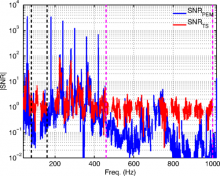
Abstract
Searches for a stochastic gravitational-wave background (SGWB) using terrestrial detectors typically involve cross-correlating data from pairs of detectors. The sensitivity of such cross-correlation analyses depends, among other things, on the separation between the two detectors: the smaller the separation, the better the sensitivity. Hence, a colocated detector pair is more sensitive to a gravitational-wave background than a noncolocated detector pair. However, colocated detectors are also expected to suffer from correlated noise from instrumental and environmental effects that could contaminate the measurement of the background. Hence, methods to identify and mitigate the effects of correlated noise are necessary to achieve the potential increase in sensitivity of colocated detectors. Here we report on the first SGWB analysis using the two LIGO Hanford detectors and address the complications arising from correlated environmental noise. We apply correlated noise identification and mitigation techniques to data taken by the two LIGO Hanford detectors, H1 and H2, during LIGO’s fifth science run. At low frequencies, 40–460 Hz, we are unable to sufficiently mitigate the correlated noise to a level where we may confidently measure or bound the stochastic gravitational-wave signal. However, at high frequencies, 460–1000 Hz, these techniques are sufficient to set a 95% confidence level upper limit on the gravitational-wave energy density of Ω(f)<7.7×10−4(f/900 Hz)3, which improves on the previous upper limit by a factor of ∼180. In doing so, we demonstrate techniques that will be useful for future searches using advanced detectors, where correlated noise (e.g., from global magnetic fields) may affect even widely separated detectors.